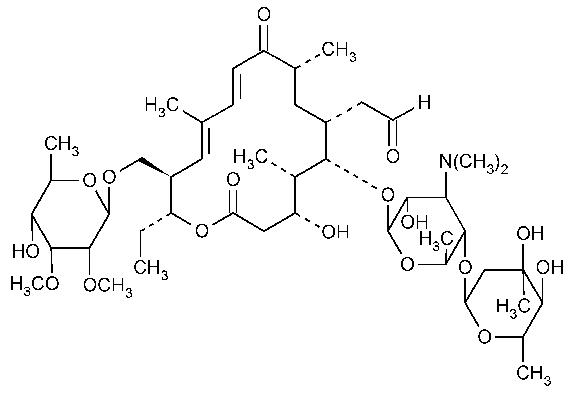Tylosin
C46H77NO17
916.1
(10E,12E)-(3R,4S,5S,6R,8R,14S,15R)-14-[(6-deoxy-2,3-di-O-methyl-b-D-allopyranosyl)oxymethyl]-5-[[3,6-dideoxy-4-O-(2,6-dideoxy-3-C-methyl-a-L-ribo-hexopyranosyl)-3-dimethylamino-b-D-glucopyranosyl]oxy]-6-formylmethyl-3-hydroxy-4,8,12-trimethyl-9-oxoheptadeca-10,12-dien-15-olide.
Tylosin A [1401-69-0].
(10E,12E)-(3R,4S,5S,6R,8R,14S,15R)-14-[(6-deoxy-2,3-di-O-methyl-b-D-allopyranosyl)oxymethyl]-5-[[3,6-dideoxy-4-O-(2,6-dideoxy-3-C-methyl-a-L-ribo-hexopyranosyl)-3-dimethylamino-b-D-glucopyranosyl]oxy]-6-formylmethyl-3-hydroxy-4,8,12-trimethyl-9-oxoheptadeca-10,12-dien-15-olide.
Tylosin A [1401-69-0].
»Tylosin is the macrolide antibiotic substance,or the mixture of such substances,produced by the growth of Streptomyces fradiae,or by any other means.Its potency is not less than 900µg of tylosin per mg,calculated on the dried basis.
Packaging and storage—
Preserve in well-closed containers,protected from light,moisture,and excessive heat.
Labeling—
Label it to indicate that it is for use in animals only.
Identification—
A:Ultraviolet Absorption á197Uñ.
Acid solution—
Transfer about 50mg of Tylosin,accurately weighed,to a 100-mLvolumetric flask,add 10mLof 2Nhydrochloric acid,dilute with water to volume,and mix.Transfer 5.0mLof this solution to a second 100-mLvolumetric flask,dilute with water to volume,and mix.Absorptivity at 290nm is 22.5±2.5,calculated on the dried basis.
Alkaline solution—
To 10.0mLof the final Acid solutionadd 1.0mLof 2Nsodium hydroxide,and heat on a water bath for 20minutes.Cool to room temperature:an absorption maximum is observed at about 332nm.
B:
The retention time of the major peak for tylosin Ain the chromatogram of the Test solutioncorresponds to that in the chromatogram of the Standard solution,as obtained in the test for Content of tylosins.
Loss on drying á731ñ—
Dry about 1g,accurately weighed,in vacuum at a pressure of not more than 5mm of mercury at 60 for 3hours:it loses not more than 5%of its weight.
for 3hours:it loses not more than 5%of its weight.
Residue on ignition á281ñ:
not more than 3.0%,the charred residue being moistened with 2mLof nitric acid and 5drops of sulfuric acid.
Heavy metals,Method IIá231ñ:
0.003%.
Limit of tyramine—
Transfer 100mg of it to a 25-mLvolumetric flask,add 5.0mLof 0.03Mphosphoric acid,and swirl to dissolve (Test solution).Transfer 5.0mLof a solution containing 70µg of tyramine per mLin 0.03Mphosphoric acid to a 25-mLvolumetric flask (Standard solution).Transfer 5mLof 0.03Mphosphoric acid to a 25-mLvolumetric flask to provide the blank.Concurrently add to each flask 1.0mLof a mixture of pyridine and 2.0mLof filtered ninhydrin solution (1in 25).Cover the flasks lightly with glass or aluminum foil caps,and heat in a water bath at 85 for not less than 20minutes.Cool rapidly to room temperature,dilute with water to volume,and mix.Promptly determine the absorbances of the solutions from the Test solutionand the Standard solutionat the wavelength of maximum absorbance at about 570nm,using the solution from the blank to zero the instrument.The absorbance of the solution from the Test solutionis not greater than that of the solution from the Standard solution(0.35%of tyramine).In a valid test the solution from the Standard solutionexhibits a dark blue color.
for not less than 20minutes.Cool rapidly to room temperature,dilute with water to volume,and mix.Promptly determine the absorbances of the solutions from the Test solutionand the Standard solutionat the wavelength of maximum absorbance at about 570nm,using the solution from the blank to zero the instrument.The absorbance of the solution from the Test solutionis not greater than that of the solution from the Standard solution(0.35%of tyramine).In a valid test the solution from the Standard solutionexhibits a dark blue color.
Content of tylosins—
Mobile phase—
Prepare a mixture of filtered 2Msodium perchlorate,previously adjusted with 1Nhydrochloric acid to a pHof 2.5±0.1,and acetonitrile (60:40).Make adjustments if necessary (see System Suitabilityunder Chromatography á621ñ).
Standard solution—
Transfer about 30mg of USP Tylosin RS,accurately weighed,to a 100-mLvolumetric flask,add 10mLof methanol,and swirl to dissolve.Dilute with water to volume,and mix.
Test solution—
Transfer about 30mg of Tylosin,accurately weighed,to a 100-mLvolumetric flask,add 10mLof methanol,and swirl to dissolve.Dilute with water to volume,and mix.
Chromatographic system (see Chromatography á621ñ)—
The liquid chromatograph is equipped with a 280-nm detector,a 4.6-mm ×20-cm column that contains 5-µm packing L1.The flow rate is about 0.7mLper minute.Chromatograph the Standard solution,and record the peak responses as directed for Procedure:the resolution,R,between the tylosin Dpeak and the tylosin Apeak is not less than 2,the tailing factor is not more than 1.5,and the relative standard deviation for replicate injections is not more than 2%.
Procedure—
Separately inject equal volumes (about 20µL)of the Standard solutionand the Test solutioninto the chromatograph,record the chromatograms over a period of time 1.5times the elution time of the main tylosin Apeak,and measure the peak areas for all the peaks.The relative retention times are about 0.5for tylosin C,0.7for tylosin B,0.9for tylosin D,and 1.0for tylosin A.Calculate the percentages of tylosin A,tylosin B,tylosin C,and tylosin Din the Tylosin taken by the formula:
100(ri/rs),
in which riis the area of the tylosin Apeak,the tylosin Bpeak,tylosin Cpeak,or the tylosin Dpeak,as appropriate,in the chromatogram obtained from the Test solution,and rsis the sum of the areas of all of the peaks in the chromatogram obtained from the Test solution:the content of tylosin Ais not less than 80%and the sum of the contents of tylosin A,tylosin B,tylosin C,and tylosin Dis not less than 95%.
Assay—
Proceed as directed for Tylosin under Antibiotics—Microbial Assays á81ñ.Prepare the Test Dilutionas follows.Transfer about 250mg of Tylosin,accurately weighed,to a 500-mLvolumetric flask,add 50mLof methanol,and swirl to dissolve.Dilute with Buffer No.3to volume,and mix.Transfer 4.0mLof this solution to a second 500-mLvolumetric flask,dilute with a mixture of Buffer No.3and methanol (1:1),and mix.This solution contains about 4µg of tylosin per mL.
Auxiliary Information—
Staff Liaison:Ian DeVeau,Ph.D.,Senior Scientist
Expert Committee:(VET)Veterinary Drugs
USP28–NF23Page 2001
Pharmacopeial Forum:Volume No.27(4)Page 2780
Phone Number:1-301-816-8178
